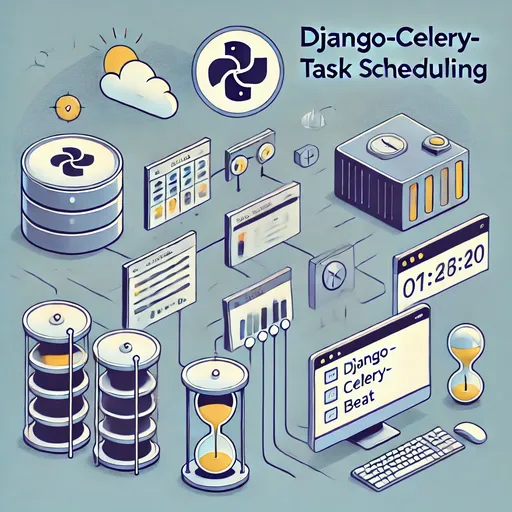When creating a web application, there are often times when you need to perform long-running tasks. For example:
- When a user signs up, you need to send a verification email.
- You have to run data cleanup tasks automatically at midnight every day.
- When a user schedules a specific task, it must be executed at the specified time.
Django works by responding immediately when a request comes in, so there is a need for a way to handle long-running tasks asynchronously. This is where Celery comes into play! 🚀
Celery is a powerful tool that helps you execute asynchronous tasks in Django, and Celery-Beat helps you execute specific tasks at scheduled times.

1️⃣ How to Set Up Scheduled Tasks in Django-Celery-Beat
There are two main ways to set up scheduled tasks in Celery-Beat.
✅ (1) Set Up Scheduling via GUI in Django Admin
Django-Celery-Beat supports setting scheduled tasks directly through the GUI in Django Admin.
📌 Features
- You can execute periodic tasks with simple settings without coding.
- You can set and modify periodic tasks through the UI on the Django admin page.
- However, since it is a static setup, it is difficult to change dynamically based on user requests.
📌 When is it Good to Use?
- When interaction between the application and users is not necessary
- Example) Automated data backup that runs at midnight every day
- Example) Updating specific API data every Monday morning
✅ (2) Dynamically Create Scheduled Tasks Using Python Code
You can also create scheduled tasks directly through code in Celery-Beat.
📌 Features
- You can dynamically create scheduled tasks based on user requests.
- You can create, change, and delete scheduled tasks through code.
- You can register periodic tasks directly from the view without going through the Admin.
📌 When is it Good to Use?
- When a scheduled task is needed upon a specific user request.
- Example) When a user places a “reserved order,” automatically register a task to cancel it after 2 hours.
- Example) When a user sets the “email reminder” feature, schedule it to send a reminder email at the specified time.
2️⃣ [Practice] Creating Scheduled Tasks with Python Code
Step 1: Define a Celery Task
from celery import shared_task
@shared_task
def send_reminder_email(user_id):
# Implement email sending logic here
print(f"📧 A reminder email has been sent to user {user_id}!")
Step 2: Create a PeriodicTask Object in Django-Celery-Beat
from django_celery_beat.models import PeriodicTask, IntervalSchedule
import json
# 1️⃣ Create the execution interval (e.g., run every 10 minutes)
schedule, created = IntervalSchedule.objects.get_or_create(
every=10, # every 10 minutes
period=IntervalSchedule.MINUTES
)
# 2️⃣ Create the PeriodicTask
task = PeriodicTask.objects.create(
interval=schedule, # execution interval
name="Send Reminder Email", # task name
task="myapp.tasks.send_reminder_email", # name of the Celery task to run
args=json.dumps([1]), # pass user ID (using example user ID 1)
)
🎯 Conclusion: Celery is Essential for Django Developers!
Celery is an essential tool for managing asynchronous tasks and enabling scheduled execution in Django.
In particular, using Celery-Beat allows you to set periodic tasks and manage scheduling dynamically based on specific events.
📌 To summarize:
- Django-Celery-Beat is a powerful tool for executing scheduled tasks.
- You can easily set periodic tasks using Django Admin (GUI).
- Creating tasks via Python code allows for dynamic management of scheduled tasks based on user requests.
- Django developers must learn the fundamental concepts of Celery and Celery-Beat!
🔥 Preview of the Next Episode
In this episode, we briefly introduced how to create scheduled tasks in Celery-Beat via code. However, in practice, you will utilize more various fields of the `PeriodicTask` model to manage more complex logic.
In the next episode, we will take a closer look at practical code for scheduling various tasks and what each field of the `PeriodicTask` model does.
If you want to learn more about advanced usage of Celery, stay tuned for the next installment! 🚀
Also, if you want to read more posts related to Celery on the blog,
check the 'Similar Posts' list below or search for “Celery” in the search box at the top right! 😊

There are no comments.